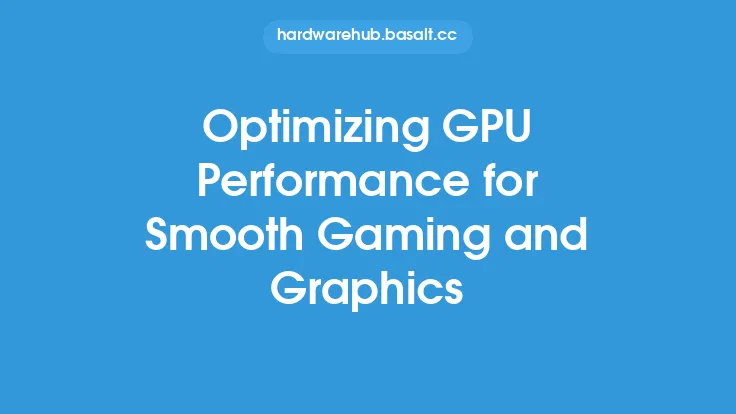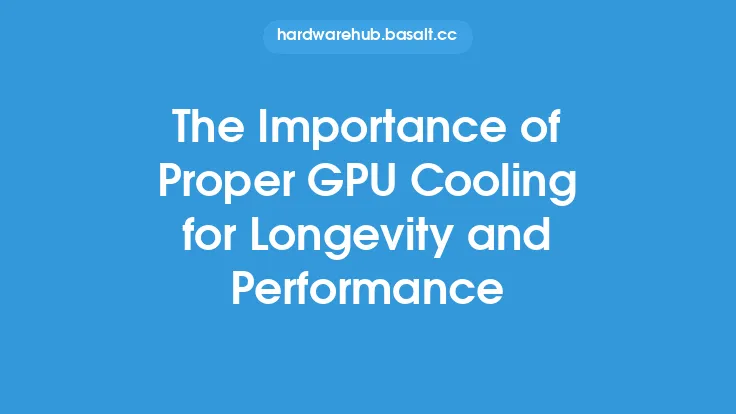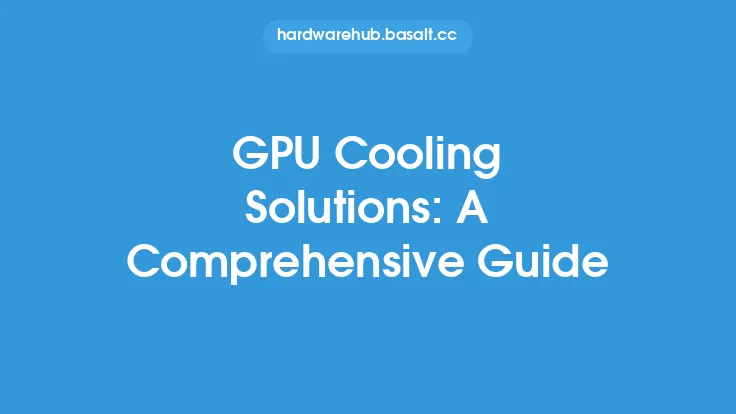When it comes to optimizing GPU performance, one crucial aspect that is often overlooked is the importance of effective cooling strategies. Graphics Processing Units (GPUs) are designed to handle complex computations and render high-quality graphics, which generates a significant amount of heat. If this heat is not properly managed, it can lead to reduced performance, throttling, and even damage to the GPU. In this article, we will delve into the world of GPU cooling and explore the various strategies that can be employed to optimize GPU performance.
Understanding GPU Thermal Dynamics
To develop effective cooling strategies, it is essential to understand the thermal dynamics of a GPU. A GPU consists of multiple components, including the graphics processing core, memory, and power management systems. Each of these components generates heat, which is then dissipated through the GPU's thermal interface. The thermal interface is typically a combination of thermal paste, heat sinks, and fans that work together to transfer heat away from the GPU. However, as the GPU operates, the thermal interface can become saturated, leading to increased temperatures and reduced performance.
Heat Transfer Mechanisms
There are several heat transfer mechanisms that play a crucial role in GPU cooling, including conduction, convection, and radiation. Conduction occurs when heat is transferred through direct contact between two objects, such as the GPU die and the heat sink. Convection occurs when heat is transferred through the movement of fluids, such as air or liquid, over the surface of the GPU. Radiation occurs when heat is transferred through electromagnetic waves, such as infrared radiation. Understanding these heat transfer mechanisms is essential for developing effective cooling strategies.
Cooling System Design
A well-designed cooling system is critical for optimizing GPU performance. The cooling system should be designed to maximize heat transfer while minimizing noise and power consumption. There are several factors to consider when designing a cooling system, including the type of heat sink, fan design, and thermal interface material. The heat sink should be designed to maximize surface area and thermal conductivity, while the fan should be designed to provide adequate airflow while minimizing noise. The thermal interface material should be chosen to provide optimal thermal conductivity and durability.
Air Cooling vs Liquid Cooling
When it comes to GPU cooling, there are two primary methods: air cooling and liquid cooling. Air cooling uses fans to circulate air over the heat sink, which dissipates heat into the surrounding environment. Liquid cooling, on the other hand, uses a liquid coolant to absorb heat from the GPU, which is then transferred to a radiator where it is dissipated. Liquid cooling is generally more effective than air cooling, especially for high-performance GPUs. However, it is also more complex and expensive to implement.
Advanced Cooling Technologies
There are several advanced cooling technologies that can be employed to optimize GPU performance, including heat pipes, vapor chambers, and phase change materials. Heat pipes use a sealed tube filled with a liquid coolant to transfer heat away from the GPU. Vapor chambers use a sealed chamber filled with a liquid coolant to absorb heat from the GPU. Phase change materials use a material that changes phase (such as from solid to liquid) to absorb and release heat. These advanced cooling technologies can provide significant improvements in cooling performance, but they are often more expensive and complex to implement.
Cooling System Maintenance
To ensure optimal GPU performance, it is essential to maintain the cooling system. This includes cleaning the heat sink and fans, replacing the thermal interface material, and checking for blockages or damage. Regular maintenance can help prevent overheating, throttling, and damage to the GPU. It is also important to monitor the cooling system's performance and adjust the cooling strategy as needed.
Conclusion
In conclusion, optimizing GPU performance with effective cooling strategies is critical for achieving optimal performance and longevity. By understanding the thermal dynamics of a GPU, heat transfer mechanisms, and cooling system design, it is possible to develop effective cooling strategies that maximize performance while minimizing noise and power consumption. Whether using air cooling or liquid cooling, advanced cooling technologies can provide significant improvements in cooling performance. Regular maintenance and monitoring of the cooling system are also essential for ensuring optimal GPU performance. By following these guidelines, it is possible to unlock the full potential of your GPU and achieve optimal performance in even the most demanding applications.





